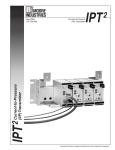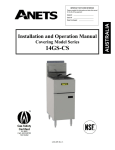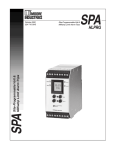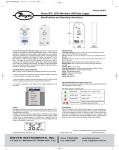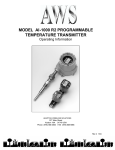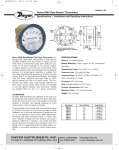Download Service Manual
Transcript
E-43-W(616) 8/16/06 8:53 AM Page 1 Bulletin E-43-W Series 616W Differential Pressure Transmitter Specifications - Installation and Operating Instructions Ø3/16 [4.76] MOUNTING HOLES TYP 4 PLACES 1-1/4 [31.75] 3-1/8 [79.38] 4-1/2 [114.30] 3-3/4 [95.25] 1-5/16 [33.32] TYP 5-1/8 7/16 OR 5/8 [130.18] [11.13 OR 15.88] TYP 1/8 AND 3/16 [3.18 AND 4.76] 1-3/16 I.D. TUBING 3/4 [30.18] 2-1/8 [19.05] TYP [53.98] 4-17/32 [115.09] 3-1/8 [79.38] Fig. A The Dwyer Series 616W Differential Pressure Transmitter senses the pressure of air and non-combustible, compatible gases and sends a standard 4-20 mA output signal. All models, including those featuring LCD digital read-out, are factory calibrated to specific ranges, as listed in the chart on the next page. Positive, negative and differential pressures can be measured within a full span accuracy of ±0.25%. This weatherproof unit is enclosed in a polycarbonate case, rated (IP66/NEMA 4X). The Span and Zero controls are for use when checking calibration. They are not intended for re-ranging to a significantly different span. DWYER INSTRUMENTS, INC. P.O. BOX 373 • MICHIGAN CITY, INDIANA 46361, U.S.A. SPECIFICATIONS Service: Air and non-combustible, compatible gases. Wetted Materials: Consult factory. Accuracy: ±0.25% F.S., display accuracy ±0.5%. Stability: +1% F.S./yr. Temperature Limits: 0 to 140°F (-17.8 to 60°C). Compensated Temperature Limits: 20 to 120°F (-6.67 to 48.9°C). Pressure Limits: See chart. Thermal Effect: ±0.02% F.S./°F (0.0012% F.S./°C). Power Requirements: 10-35 VDC (2-wire). Output Signal: 4 to 20 mA. Zero and Span Adjustments: Potentiometers for zero and span. Loop Resistance: DC; 0-1250 ohms maximum. Current Consumption: DC; 38 mA maximum. Electrical Connections: Screw-type terminal block. Process Connections: Barbed, dual size to fit 1/8˝ and 3/16˝ (3.12 and 4.76 mm) I.D. rubber or vinyl tubing. Enclosure Rating: NEMA 4X (IP66). Mounting Orientation: Vertical, consult factory for other position orientations. Weight: Without LCD 8.8 oz (249 g); with LCD 9.6 oz (272 g). Agency Approvals: CE. Phone: 219/879-8000 Fax: 219/872-9057 www.dwyer-inst.com e-mail: [email protected] E-43-W(616) 8/16/06 8:53 AM Page 2 SERIES 616W TRANSMITTER MODELS & RANGES MODEL NUMBER PRESSURE RANGE MAXIMUM DIGITAL PRESSURE DISPLAY 616W-0 616W-1 616W-2 616W-3 616W-4 616W-5 616W-6 616W-7 616W-8 616W-9 616W-10 616W-11 616W-12 616W-3B 616W-6B 616W-10B 616W-20B 616W-00-LCD 616W-0-LCD 616W-1-LCD 616W-2-LCD 0-2 in.w.c. 0-3 in.w.c. 0-6 in.w.c. 0-10 in.w.c. 0-20 in.w.c. 0-40 in.w.c. 0-100 in.w.c. 0-200 in.w.c. 0-10 psid 0-20 psid 0-30 psid 0-50 psid 0-100 psid 1.5-0-1.5 in.w.c. 3-0-3 in.w.c. 5-0-5 in.w.c. 10-0-10 in.w.c. 0-1 in.w.c. 0-2 in.w.c. 0-3 in.w.c. 0-6 in.w.c. 5 psig 5 psig 5 psig 5 psig 11 psig 11 psig 29 psig 29 psig 58 psig 58 psig 58 psig 150 psig 150 psig 5 psig 5 psig 5 psig 11 psi 5 psig 5 psig 5 psig 5 psig 0-1.00 0-2.00 0-3.00 0-6.00 MODEL NUMBER 616W-3-LCD 616W-4-LCD 616W-5-LCD 616W-6-LCD 616W-7-LCD 616W-8-LCD 616W-9-LCD 616W-10-LCD 616W-11-LCD 616W-12-LCD 616W-3B-LCD 616W-6B-LCD 616W-10B-LCD 616W-20B-LCD 616W-OM-LCD 616W-1M-LCD 616W-2M-LCD 616W-3M-LCD 616W-4M-LCD 616W-5M-LCD PRESSURE RANGE MAXIMUM DIGITAL PRESSURE DISPLAY 0-10 in.w.c. 0-20 in.w.c. 0-40 in.w.c. 0-100 in.w.c. 0-200 in.w.c. 0-10 psid 0-20 psid 0-30 psid 0-50 psid 0-100 psid 1.5-0-1.5 in.w.c. 3-0-3 in.w.c. 5-0-5 in.w.c. 10-0-10 in.w.c. 0-500 Pa 0-750 Pa 0-1.5 kPa 0-2.5 kPa 0-5 kPa 0-25 kPa 5 psig 11 psig 11 psig 29 psig 29 psig 58 psig 58 psig 58 psig 150 psig 150 psig 10 in.w.c. 5 psig 5 psig 11 psig 34.5 kPa 34.5 kPa 34.5 kPa 34.5 kPa 75.8 kPa 200 kPa 0-10.00 0-20.0 0-40.0 0-100.0 0-200 0-10.0 0-20.0 0-30.0 0-50.0 0-100.0 -1.50-0-1.50 -3.00-0-3.00 -5.00-0-5.00 -10.00-0-10.00 0-500 0-750 0-1.50 1-2.50 0-5.00 0-25.0 INSTALLATION 1. Location: Select a clean, dry mounting location free from excess vibration where the temperature will remain between 20 and 120˚F (-6.7 and 49˚C). Distance from the receiver is limited only by total loop resistance. See Electrical Connections below. The tubing supplying pressure to the instrument can be practically any length required, but long lengths will increase response time slightly. 2. Position: A vertical position, with the pressure connection pointing down, is recommended. That is the position in which all standard models are spanned and zeroed at the factory. They can be used at other angles, but final spanning and zeroing must be done while transmitter is in that alternate position. 3. Pressure Connections: Two integral barbed tubing connections are provided. They are dual-sized to fit both 1/8˝ and 3/16˝ (3.2 and 4.8 mm) I.D. tubing. Be sure the pressure rating of the tubing exceeds that of the operating range. On ranges over 20 psi, we recommend use of a suitable hose clamp to assure the integrity of the connection. ELECTRICAL CONNECTIONS Fig. B Wire Length - The maximum length of wire connecting transmitter and receiver is a function of wire size and receiver resistance. Wiring should not contribute more than 10% of the receiver resistance to total loop resistance. For extremely long runs (over 1000 feet), choose receivers with higher resistance to minimize size and cost of connecting leads. Where wiring length is under 100 feet, hook-up wire as small as 22 AWG can be used. 2-Wire Operation - An external power supply delivering 10-35 VDC with minimum current capability of 40 mA DC (per transmitter) must be used to power the control loop. See Fig. C for connection of the power supply, transmitter and receiver. Note the jumper between terminals 3 and 4. The range of appropriate receiver load resistance (RL) for the DC power supply voltage available is expressed by the formula. CAUTION: Do not exceed specified supply voltage ratings. Permanent damage not covered by warranty will result. This unit is not designed for 120 or 240 volts AC line operation. RL Max = Vps - 10V 20mA DC Electrical connections are made to the terminal block located on the inside of the transmitter. Terminals are marked 1, 2, 3 and 4. See Fig. B. Determine which of the following circuit drawings applies to your application and wire accordingly. Shielded two wire cable is recommended for control loop wiring. If grounding is required, use the negative side of the control loop after the receiver. Otherwise, in 2-wire operation it is not necessary to observe polarity of control loop connections. 2-Wire Connections 1 616W PRESSURE TRANSMITTER 2 mA 3 4 JUMPER WIRE RECEIVER Fig. C 2 POWER SUPPLY 10-35 VDC E-43-W(616) 8/16/06 8:53 AM Page 3 Calibration Check - Each Series 616W Transmitter is factory calibrated to the range given in the model chart. To check calibration and adjust if necessary, the following procedure should be used. For purposes of clarification in these instructions, range is defined as that pressure which, applied to the transmitter, produces 20 milliamps of current in the loop. Zero pressure is always assumed to be 4 milliamps. 1. With the transmitter connected to the companion receiver, insert an accurate milliameter in series with the current loop. Full scale range should be approximately 30 mA. 2. Connect a controllable pressure source to one leg of a tee with the other two legs connected to the high pressure port of the transmitter and the third leg to an accurate test gage or manometer, in an appropriate range. The low pressure port should be vented to atmosphere. Calibration must be performed with the unit in the same position in which it will be mounted. 3. Apply electrical power to the unit and allow it to stabilize for 10 minutes. MULTIPLE RECEIVER INSTALLATION An advantage of the standard 4-20 mA DC output signal produced by the Series 616W Transmitter is that any number of receivers can be connected in series in the current loop. Thus, an A-701 Digital Readout, an analog panel meter, a chart recorder, process controlling equipment or any combination of these devices can be operated simultaneously. The only requirement is that each component be equipped for a standard 4-20 mA input and the proper polarity of the input connections be observed when inserting the device in the current loop. If any of the units display a negative or downscale reading, the signal input leads are reversed. MAINTENANCE Upon final installation of the Series 616W Differential Pressure Transmitter, no routine maintenance is required. A periodic check of the system calibration is recommended following the procedures explained under Calibration Check. The Series 616W Transmitter is not field serviceable and should be returned, freight prepaid, to the factory if repair is required. Please enclose a description of the problems encountered plus any available application information. Contact customer service to receive a return goods authorization number before shipping. 4. With no pressure applied to the transmitter, adjust ZERO control so that loop current is 4 mA. See Fig. K. 5. Apply full range pressure and adjust loop current to 20 mA using SPAN control. 6. Relieve pressure and allow transmitter to stabilize for 2 minutes. 7. Zero and span controls are slightly interactive, so repeat steps 4 through 6 until zero and full range pressures consistently produce currents of 4 and 20 mA respectively. 8. Remove the milliameter from the current loop and proceed with final installation of the transmitter and receiver. SPAN ADJUST ZERO ADJUST Fig. K 3 E-43-W(616) 8/16/06 8:53 AM Page 4 ©Copyright 2006 Dwyer Instruments, Inc. DWYER INSTRUMENTS, INC. P.O. BOX 373 • MICHIGAN CITY, INDIANA 46361, U.S.A. Printed in U.S.A. 8/06 Phone: 219/879-8000 Fax: 219/872-9057 FR# 01-440886-01 Rev. 2 www.dwyer-inst.com e-mail: [email protected]




